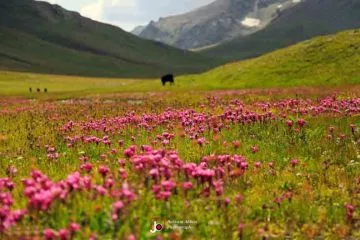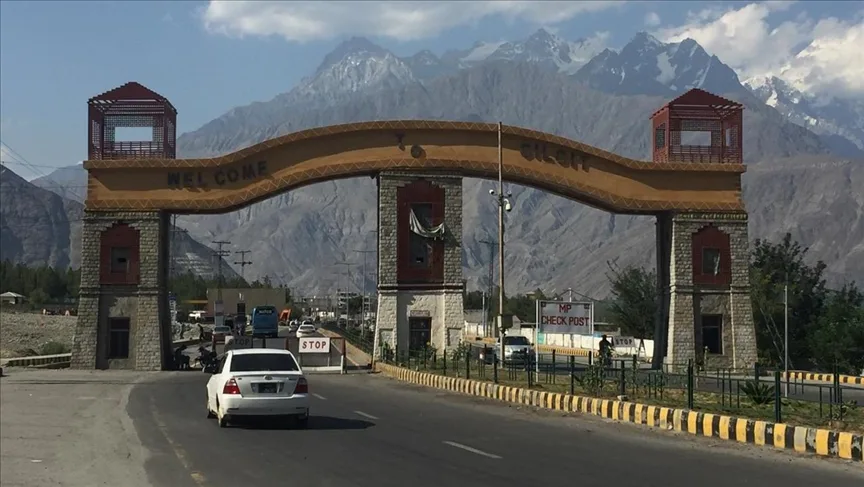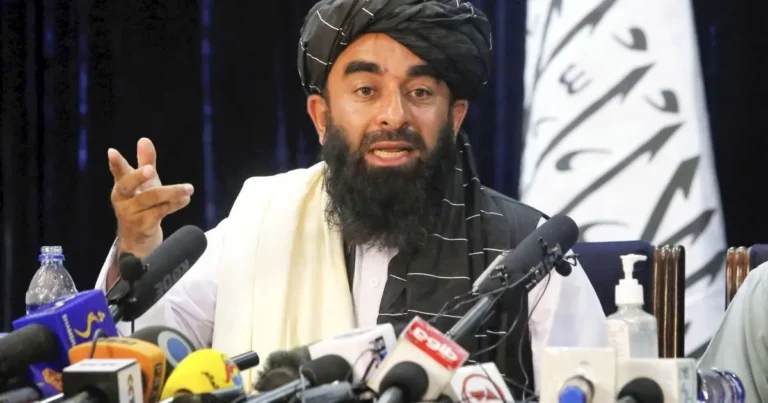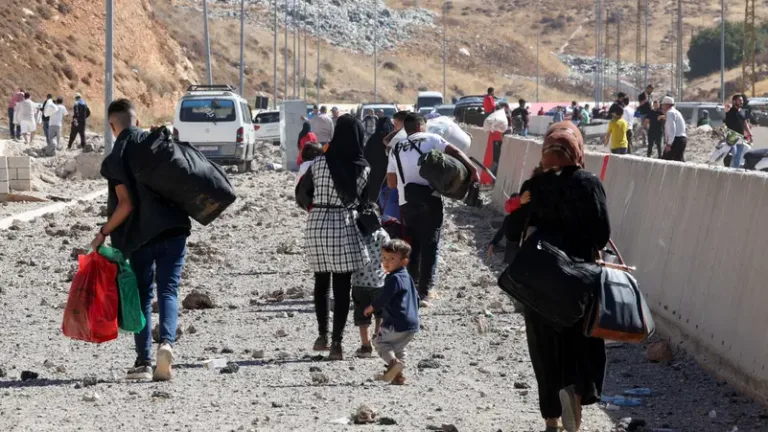“Explosive Secrets Revealed: Unmasking the Hidden Truth Behind Gilgit-Baltistan’s Shocking Protest!”
Gilgit-Baltistan, a region marked by a history of Sunni-Shia rivalry, found itself in a state of tension last Friday as protests erupted in Gilgit and its surroundings. These demonstrations were organized by a Shia group in response to derogatory remarks allegedly made by a prominent Sunni cleric during a protest in Gilgit.
1.Do you know the Enchanting Beauty and Cultural Diversity of Gilgit-Baltistan
2.why Gilgit-Baltistan gained significance
On Sunday 03 september 2023, Pakistan’s interim Information Minister, Murtaza Solangi, sought to reassure the public by stating that the situation in Gilgit-Baltistan was “completely peaceful.” This declaration came in the wake of reports of sectarian tensions, which prompted authorities to indefinitely suspend mobile internet services.
Solangi emphasized that the rumors circulating about the deployment of Pakistan Army were baseless, citing an official statement from the region’s home department. According to the minister, all roads, trade centers, businesses, and educational institutions in the area were operating as usual.

To maintain law and order during the observance of chehlum or Arbaeen, special measures had been taken, including the requisitioning of Pakistan Army and civil armed forces. Additionally, section 144 was imposed across the region to safeguard lives and prevent any untoward incidents.
Solangi acknowledged that peaceful protests occasionally arise in response to religious and sectarian concerns but maintained that the overall law-and-order situation remained calm. He dismissed reports of unrest as baseless.
The unrest that began with protests in Gilgit continued due to alleged derogatory statements made by both Sunni and Shia figures. An FIR was registered against the Sunni cleric at the City Police Station Gilgit for his comments, while another FIR against a prominent Shia cleric had been registered in Skardu.
In response to sectarian posts on social media, authorities in the region suspended two police personnel and a schoolteacher and detained over 12 individuals who had posted controversial content.
Meanwhile, mobile internet services have been suspended across the region until further notice. In light of the situation, the United Kingdom joined Canada and the US in advising its citizens to avoid visiting the northern areas.”
The tension in Gilgit-Baltistan can be attributed to several factors, including historical, religious, and social factors. Here are some key reasons for the ongoing tension in the region:
Religious and Sectarian Differences: One of the primary causes of tension in Gilgit-Baltistan is the longstanding religious and sectarian divide between Sunni and Shia Muslims. The region has a history of sectarian clashes and communal tensions, with each group having its own religious beliefs and practices.
Derogatory Remarks: The recent bout of tension was triggered by derogatory remarks allegedly made by a prominent Sunni cleric during a protest in Gilgit. Such incidents, where religious leaders or individuals from one sect insult or provoke the other, can quickly escalate tensions.
Historical Rivalry: Gilgit-Baltistan has a complex history of political and ethnic rivalries, which sometimes overlap with religious differences. These historical rivalries can resurface and contribute to the overall tension in the region.
Social Media and Online Hate Speech: The spread of hate speech and provocative content on social media platforms has played a role in exacerbating tensions. Authorities have taken action against individuals posting controversial content on social media in an attempt to control the situation.
Political Factors: Political dynamics and governance issues can also contribute to tension. Disputes over political representation, resource allocation, and local governance can escalate into broader conflicts.
External Factors: Sometimes, external actors and foreign interests can fuel tensions in the region for their own geopolitical objectives. Regional power struggles and international influences can exacerbate local issues.

Lack of Trust: A lack of trust between different communities and between the local population and government authorities can be a contributing factor. When people feel marginalized or unheard, it can lead to grievances and unrest.
It’s important to note that tension in Gilgit-Baltistan is a complex issue with multiple dimensions, and the specific triggers and dynamics can vary over time. Addressing these tensions often requires a multifaceted approach that involves dialogue, conflict resolution, community engagement, and efforts to promote tolerance and understanding among different groups in the region.
“Do you know the Enchanting Beauty and Cultural Diversity of Gilgit-Baltistan”

1.Do you know the Enchanting Beauty and Cultural Diversity of Gilgit-Baltistan
Gilgit-Baltistan is a region in northern Pakistan known for its stunning natural beauty and unique cultural heritage. Several things make Gilgit-Baltistan famous.
Scenic Landscapes: Gilgit-Baltistan is renowned for its breathtaking landscapes. It is home to some of the world’s highest peaks, including K2, the second-highest mountain on Earth. The region also features numerous other snow-capped mountains, glaciers, valleys, and pristine lakes, making it a paradise for adventure enthusiasts and nature lovers.
Karakoram Highway: The Karakoram Highway (KKH) is one of the world’s highest international roads, connecting Pakistan to China. It passes through Gilgit-Baltistan, offering travelers stunning views of the Karakoram Range and the Himalayas.
Cultural Diversity: Gilgit-Baltistan is home to diverse ethnic and linguistic groups, including Balti, Shina, and Burushaski-speaking communities. This cultural diversity is reflected in their music, dance, and traditional festivals.
Ancient History: The region has a rich history, with evidence of human habitation dating back thousands of years. It was an important part of the ancient Silk Road trade route, and there are archaeological sites and ancient petroglyphs that provide insights into its history.
Mountaineering and Adventure Tourism: Gilgit-Baltistan is a mecca for mountaineers and adventure seekers from around the world. It offers opportunities for trekking, mountaineering, rock climbing, and white-water rafting, attracting adventurers looking to conquer some of the world’s highest peaks.
Cultural Heritage: The region is known for its unique architectural heritage, including ancient mosques, forts, and traditional houses built using local materials and craftsmanship. Baltit Fort and Khaplu Palace are notable examples of this heritage.
Diverse Flora and Fauna: The region boasts a wide variety of flora and fauna, including rare and endangered species like the snow leopard and the Marco Polo sheep. The Deosai National Park, known as the “Land of Giants,” is a high-altitude plateau with unique biodiversity.
Hospitality: The people of Gilgit-Baltistan are known for their warm hospitality and friendliness towards visitors. Traditional music and dance performances are often part of the welcome ceremonies for tourists.
Political Importance: The region has had a complex political history due to its strategic location. It has been a point of contention between India and Pakistan, and its status remains a subject of dispute. In 2009, the Pakistani government formally recognized Gilgit-Baltistan as a self-governing region.
Economic Significance: Gilgit-Baltistan is an important area for trade and commerce, as it serves as a gateway to China through the Karakoram Highway. The region’s economy is largely based on agriculture, tourism, and trade.
Overall, Gilgit-Baltistan is famous for its stunning natural beauty, cultural diversity, and historical significance, making it a must-visit destination for those interested in adventure, culture, and the outdoors.
why Gilgit-Baltistan gained significance ?
2.why Gilgit-Baltistan gained significance
Gilgit-Baltistan gained significance for several reasons, including its strategic location, natural resources, and its role in regional connectivity. Here are some key factors that contributed to its significance:

Strategic Location: Gilgit-Baltistan is strategically located in northern Pakistan, sharing borders with China, India, and Afghanistan. Its proximity to China’s western Xinjiang region makes it a crucial region for trade and connectivity. It also has a vital role in the defense and security considerations of Pakistan.
Gateway to China: Gilgit-Baltistan serves as a gateway to China through the Karakoram Highway (KKH), one of the world’s highest international roads. This road connects Pakistan to China’s western provinces and has become a key trade route between the two countries. It plays a pivotal role in the China-Pakistan Economic Corridor (CPEC), a major infrastructure project aimed at enhancing economic connectivity and trade between China and Pakistan.
Natural Resources: The region is rich in natural resources, including minerals, precious stones, and hydropower potential. The exploitation of these resources can have economic implications, making Gilgit-Baltistan attractive for investment and development.
Tourism: Gilgit-Baltistan’s stunning natural beauty, including its high mountains, glaciers, valleys, and lakes, has made it a popular tourist destination. Tourism contributes to the region’s economy and has the potential for further growth and development.
Geostrategic Importance: Due to its location near the borders of India and China, Gilgit-Baltistan has been a focus of geopolitical competition and strategic interests. The region’s status and control have implications for regional stability and influence.
Cultural Diversity: Gilgit-Baltistan’s diverse cultural heritage and historical significance also contribute to its significance. The region’s cultural exchanges and interactions with neighboring countries, particularly China and Central Asia, have historical roots and continue to play a role in regional dynamics.
Transportation Hub: In addition to the KKH, Gilgit-Baltistan is home to several airports and is a key transportation hub for the northern areas of Pakistan. Improved transportation infrastructure enhances regional connectivity and trade.

Overall, Gilgit-Baltistan’s significance stems from its location at the crossroads of South Asia, Central Asia, and China, its role in regional connectivity and trade, its natural resources, and its cultural heritage. The region’s importance is likely to continue evolving as regional dynamics and economic interests shift over time.
Food Of GilGat BilTistaN
Gilgit-Baltistan, like many regions in Pakistan, has its own distinct cuisine influenced by its geography, culture, and available ingredients. Some of the famous foods and dishes you can find in Gilgit-Baltistan include:
Chapshuro: This is a popular local dish made by filling unleavened bread with minced meat (often yak or mutton) and various spices. It’s typically folded into a half-moon shape and then pan-fried or baked.
Momo: Similar to dumplings found in other Asian cuisines, momos are a beloved snack in Gilgit-Baltistan. They are typically filled with meat (yak, mutton, or chicken) and served with a dipping sauce.
Yak Meat: Yak meat is a specialty in this region due to the presence of yaks in the high-altitude areas. It’s used in various dishes, such as stews and kebabs, and is appreciated for its lean and tender quality.
Goshtaba: This is a rich and creamy meatball dish made with finely ground meat (usually mutton or beef) and cooked in a yogurt-based gravy with aromatic spices.
Harisa: Harisa is a slow-cooked porridge-like dish made from wheat and meat (often chicken or mutton). It’s a traditional breakfast dish and is particularly popular during the winter months.
Nashta: Nashta refers to a variety of snacks and sweets found in Gilgit-Baltistan. These can include pakoras (deep-fried fritters), jalebi (a sweet syrupy dessert), and various types of bread, such as phitti and bakarkhani.
Butter Tea (Chai): Given the cold climate in many parts of Gilgit-Baltistan, butter tea is a common and warming beverage. It’s made by churning tea leaves with yak butter and salt, resulting in a unique and hearty drink.
Dried Apricots: Gilgit-Baltistan is known for its delicious dried apricots, which are grown abundantly in the region. These are not only enjoyed as snacks but also used in various dishes and desserts.
Local Breads: Various types of bread are a staple in the local diet. These include chapati (unleavened flatbread), phitti (a type of thick bread), and bakarkhani (a sweet and flaky bread).
Lassi: Lassi is a popular yogurt-based drink that can be sweet or salty. In Gilgit-Baltistan, it’s often served as a refreshing beverage.
The cuisine of Gilgit-Baltistan reflects the region’s mountainous terrain, cold climate, and the availability of certain ingredients like yak meat and dried fruits. It’s a unique and flavorful cuisine that combines traditional flavors with the culinary traditions of the region.
What is Fruit Of Gilgat Biltistan?
Gilgit-Baltistan is known for its abundant fruit production, and it’s famous for several types of fruits that thrive in its cool and temperate climate. Some of the prominent fruits grown in Gilgit-Baltistan include:
Apricots: Gilgit-Baltistan is particularly renowned for its apricots. The region produces a wide variety of apricot types, and dried apricots from Gilgit-Baltistan are highly sought after for their flavor and quality.
Apples: Apples are another major fruit crop in the region. The apples from Gilgit-Baltistan are known for their crispness and sweetness. Varieties like Kala Kulu and Golden Delicious are popular.
Cherries: Cherries are grown in abundance in the region. They are not only enjoyed fresh but are also used for making cherry preserves, jams, and desserts.
Plums: Various types of plums, including damson plums, are cultivated in Gilgit-Baltistan. They are used to make jams and pickles.
Pears: Pears, both European and Asian varieties, are grown in the orchards of Gilgit-Baltistan.
Walnuts: Walnuts are a significant nut crop in the region. They are often consumed as snacks and are used in various dishes and desserts.
Grapes: Grapes are cultivated in some parts of Gilgit-Baltistan, primarily for local consumption and making traditional grape juices.
Mulberries: Mulberries are a seasonal fruit that grows in Gilgit-Baltistan. They are enjoyed fresh and are also used to make traditional sweets and desserts.
Peaches: Peaches are grown in various regions of Gilgit-Baltistan, and they are used in fresh fruit dishes and desserts.
The fruit orchards of Gilgit-Baltistan benefit from the region’s favorable climate, with cold winters and temperate summers. The fruit produced in this region is not only consumed locally but is also distributed to other parts of Pakistan. The fruit of Gilgit-Baltistan is known for its quality and taste, making it an essential part of the region’s agriculture and economy.
Is Gilgat Biltistan Safe for Visitors?
The safety of travel and stay in Gilgit-Baltistan, like in any other destination, can be influenced by various factors, including the current political situation, weather conditions, and personal choices. As of my last knowledge update in September 2023, here are some considerations regarding travel and safety in Gilgit-Baltistan:
Political Situation: Gilgit-Baltistan has, in the past, experienced political unrest and tensions related to its status within Pakistan and the broader Kashmir conflict. It’s essential to stay informed about the current political climate and any potential travel advisories issued by your government.
Weather Conditions: The region experiences extreme weather conditions, particularly in the winter months when heavy snowfall can disrupt travel plans and access to certain areas. Summers are generally more suitable for tourists.
Infrastructure: While there have been improvements in recent years, the infrastructure in some parts of Gilgit-Baltistan, especially in remote areas, may be basic. Road conditions can vary, so be prepared for some challenging travel.
Health and Medical Facilities: Access to healthcare facilities can be limited in remote areas. It’s advisable to carry necessary medications and consult a healthcare professional before traveling.
Cultural Sensitivity: Gilgit-Baltistan is home to diverse ethnic and cultural groups. It’s essential to respect local customs and traditions, including dress codes and appropriate behavior.
Adventure Activities: The region is famous for adventure activities like trekking and mountaineering. If you plan to engage in these activities, make sure you are adequately prepared, have the right equipment, and, if necessary, hire experienced local guides.
Accommodation: Accommodation options can vary from basic guesthouses to more comfortable hotels in larger towns and cities. It’s advisable to book accommodations in advance, especially during the peak tourist season.
Travel Permits: Depending on your nationality and the areas you plan to visit, you may need special permits to travel in certain parts of Gilgit-Baltistan. Check the requirements and obtain the necessary permits in advance.
Local Advice: Seek advice from locals or travel agencies familiar with the region. They can provide valuable information on safety, routes, and current conditions.
Emergency Contacts: Make sure you have essential emergency contacts, including local authorities, your embassy or consulate, and a means of communication in case of emergencies.
As the situation can change over time, it’s crucial to check for the most up-to-date information and travel advisories from reliable sources, such as government travel websites or reputable travel agencies, before planning your trip to Gilgit-Baltistan. Additionally, consider your own comfort level, experience, and preparedness when deciding to travel to remote or less-developed regions.
Do you know How Much Important is Gilgat Biltistan For CEPEC
Gilgit-Baltistan is of significant importance to the China-Pakistan Economic Corridor (CPEC), a major infrastructure and economic development project that aims to connect China’s western region to Pakistan’s Gwadar Port on the Arabian Sea. Several factors highlight the importance of Gilgit-Baltistan to the CPEC:
Strategic Location: Gilgit-Baltistan’s geographical location is strategically vital for the CPEC. It serves as the gateway to the western regions of China, particularly Xinjiang. The Karakoram Highway (KKH), which passes through Gilgit-Baltistan, is a critical component of the CPEC, providing an overland route for trade and connectivity.
Transportation Hub: Gilgit-Baltistan is a key transportation hub within the CPEC. The region’s road networks, including the KKH and associated infrastructure projects, play a crucial role in facilitating the movement of goods between China and Pakistan and onward to Gwadar Port.
Resource Rich: Gilgit-Baltistan is rich in natural resources, including minerals, precious stones, and hydropower potential. The development and utilization of these resources are integral to the economic objectives of the CPEC.
Economic Opportunities: The CPEC aims to create economic opportunities in Gilgit-Baltistan and other regions of Pakistan. It includes the development of industrial zones, energy projects, and infrastructure improvements that can stimulate economic growth and job creation in the region.
Trade and Connectivity: The CPEC enhances trade connectivity between China and Pakistan and facilitates access to international markets. This connectivity can benefit Gilgit-Baltistan by improving its access to markets in both China and Pakistan.
Tourism Potential: Gilgit-Baltistan’s stunning natural beauty and cultural attractions have the potential to attract tourism, which can further boost the local economy and provide employment opportunities.
Security Considerations: Given its significance, Gilgit-Baltistan has received attention from both Chinese and Pakistani authorities to ensure the security and stability of the region, which is crucial for the successful implementation of the CPEC.
However, it’s worth noting that the region’s status is subject to political complexities, as Gilgit-Baltistan’s legal and political status is disputed and part of a broader territorial dispute between India and Pakistan. The involvement of Gilgit-Baltistan in the CPEC has also been a point of contention in the region.
In summary, Gilgit-Baltistan plays a vital role in the China-Pakistan Economic Corridor due to its strategic location, transportation infrastructure, resource potential, and economic significance. Its development and stability are closely tied to the success of the CPEC and its broader economic objectives.






